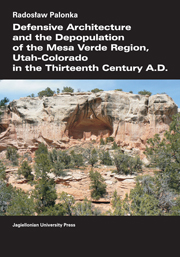Book contents
- Frontmatter
- Dedication
- Contents
- List of Figures
- Acknowledgments
- CHAPTER I Introduction
- CHAPTER II Mesa Verde region – definition, natural environment, history and methodology of research
- CHAPTER III Defining and interpreting defensive architecture
- CHAPTER IV Ethnography, ethnohistory, and Native American oral traditions concerning defensive architecture and conflicts in the Southwest
- CHAPTER V Analysis of the central Mesa Verde region architecture in the thirteenth century A.D.
- CHAPTER VI Summary and conclusions
- REFERENCES
- PHOTOGRAPHS
CHAPTER II - Mesa Verde region – definition, natural environment, history and methodology of research
Published online by Cambridge University Press: 05 September 2014
- Frontmatter
- Dedication
- Contents
- List of Figures
- Acknowledgments
- CHAPTER I Introduction
- CHAPTER II Mesa Verde region – definition, natural environment, history and methodology of research
- CHAPTER III Defining and interpreting defensive architecture
- CHAPTER IV Ethnography, ethnohistory, and Native American oral traditions concerning defensive architecture and conflicts in the Southwest
- CHAPTER V Analysis of the central Mesa Verde region architecture in the thirteenth century A.D.
- CHAPTER VI Summary and conclusions
- REFERENCES
- PHOTOGRAPHS
Summary
DEFINITION AND BORDERS OF THE CENTRAL MESA VERDE REGION
The Mesa Verde region is part of a larger area called the North American Southwest (Fig. 1). Archaeologically, the North American Southwest covers the approximate area of what is today Utah, Colorado, Arizona, New Mexico, southern California, southeastern Nevada, and western Texas in the U.S., and northern portions of the states of Sonora and Chihuahua in Mexico (Cordell 1997; Plog 1997). This area includes diverse geography and climatic conditions, though dry semi-desert plains prevail; these plains are interrupted by plateaus and mountain ranges with many pine and spruce woodlands.
Archaeologically, the Mesa Verde region includes adjacent parts of what are presently southeastern Utah, southwestern Colorado, northeastern Arizona, and northwestern New Mexico. These four states meet at what is known as the Four Corners, and that general area is referred to as the Four Corners area of the U.S. The Mesa Verde region is also known as the Northern San Juan region, and these two terms are often used interchangeably (Lipe 1995a: 143–144; Rohn 1989: 149–150; Varien 2000: 6). San Juan River begins in southern Colorado (in the San Juan Mountains), passes through the northwestern part of New Mexico, and feeds into Colorado River in Utah; this river might have been treated as a natural boundary in ancient times, and it roughly serves as a cultural boundary between the Mesa Verde region and areas to the south, including the Chaco region in northwestern New Mexico and the Kayenta region in northeastern Arizona.
- Type
- Chapter
- Information
- Defensive Architecture and the Depopulation of the Mesa Verde Region, Utah-Colorado in the Thirteenth Century AD , pp. 19 - 37Publisher: Jagiellonian University PressPrint publication year: 2011



